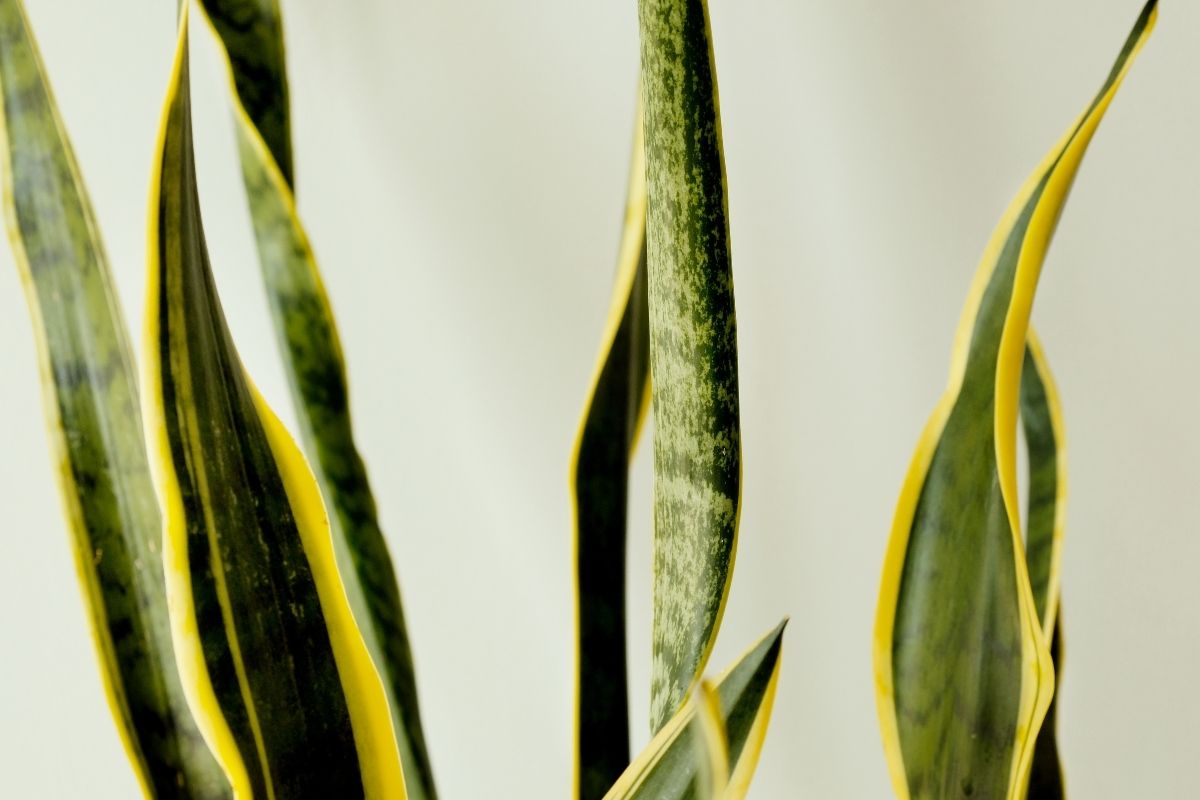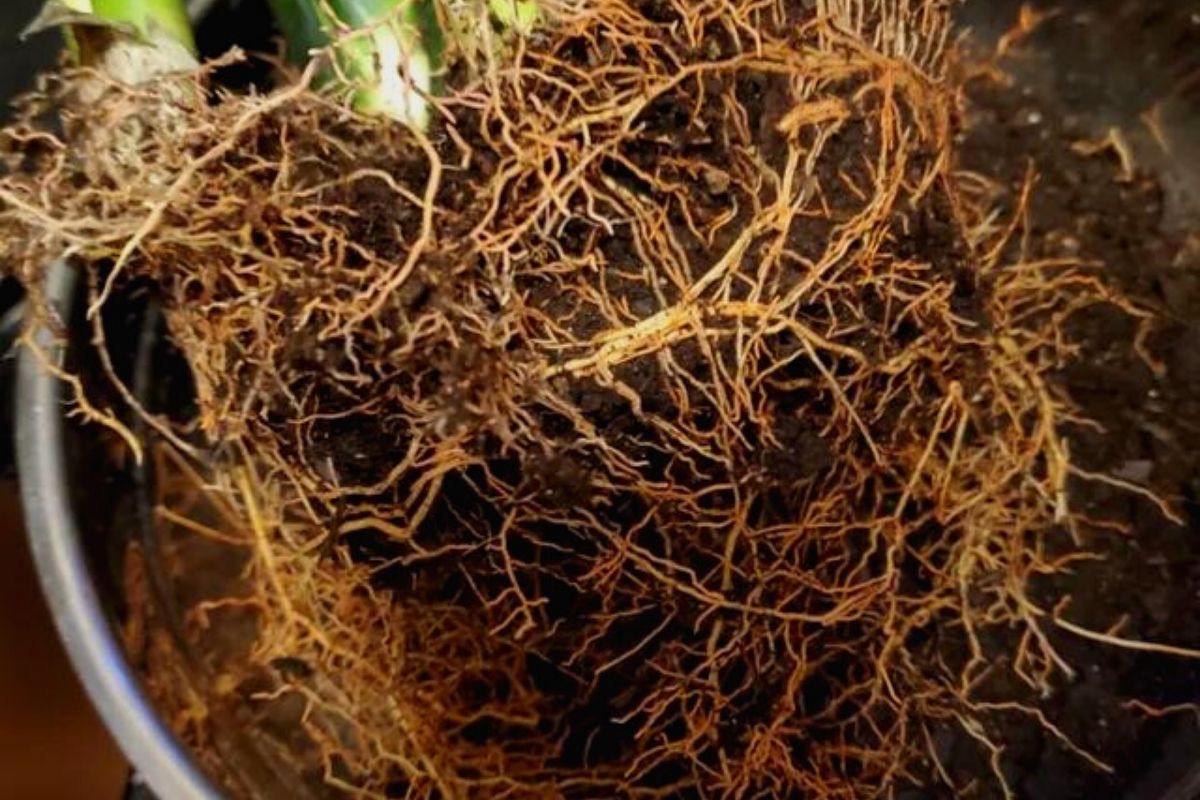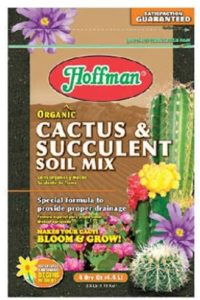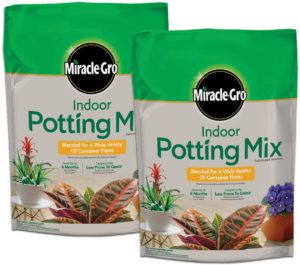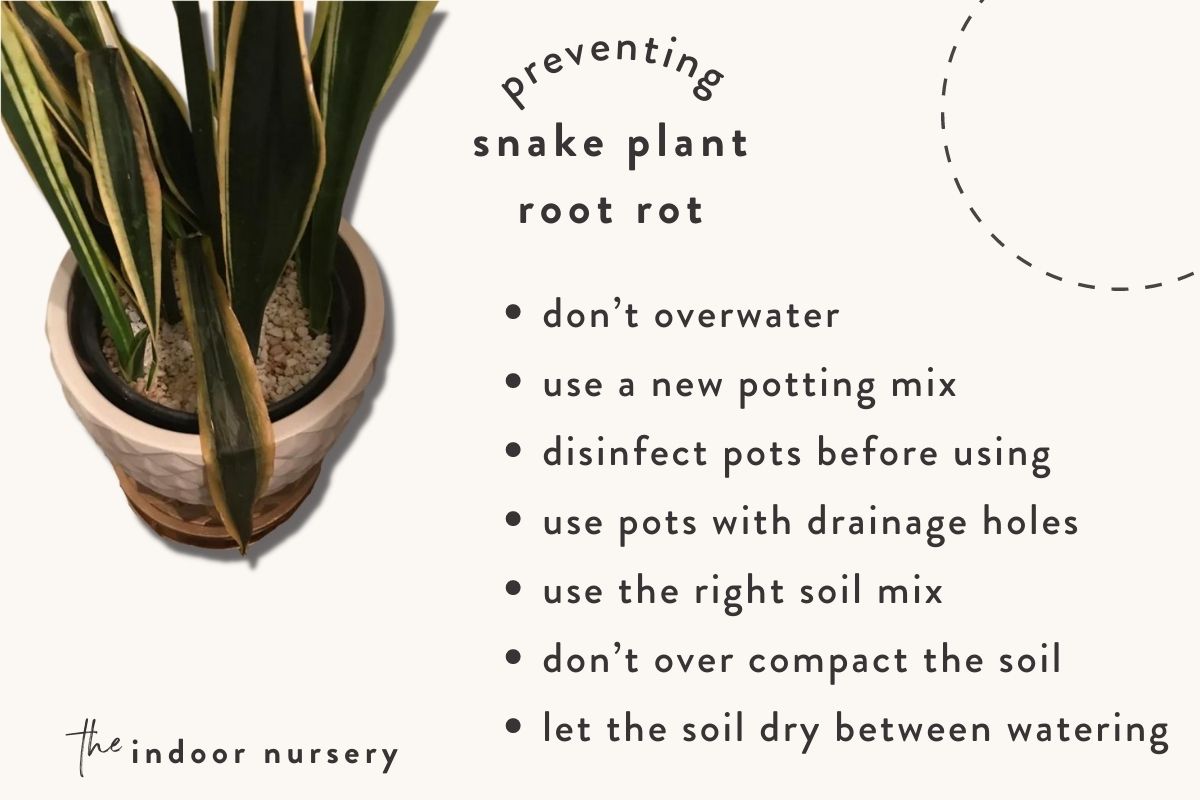Your snake plant can survive a lot – but gasp! What’s that? Snake plant root rot? This is a serious problem if you don’t act fast.
It seems like those moments when you think you can do no wrong are exactly when those pesky brown spots and early signs of withering start to show.
😒 Snake plant root rot.
Read on to learn about the early signs or root rot in snake plants and what you can do about it… and how to keep your snake plant healthy to begin with! Yeah, we go there.
What is root rot?
Root rot is a common houseplant disease that is typically caused by a fungal infection or prolonged exposure to a wet environment (e.g. water sitting in the bottom of your snake plant’s pot), limiting oxygen access to roots and causing the tissue to decay. Even without fungal infection, standing water alone can suffocate your snake plant’s roots and lead to big time trouble!
Pathogens like fungus tend to thrive in wet environments. Fungus might be present in a plant’s soil for a long period of time, and only flourish when exposed to wet conditions, leading to a messy decomp situation where the sun don’t shine 😬
A healthy snake plant (with healthy roots) will be able to withstand a few pathogens and pests as they appear, buuuut prolonged soggy soil will turn healthy roots to mush.
Whatever the cause, root rot cuts off your snake plant’s access to oxygen and nutrients in soil. This can quickly kill your plant if you don’t do something about it, ASAP!
Signs of snake plant root rot
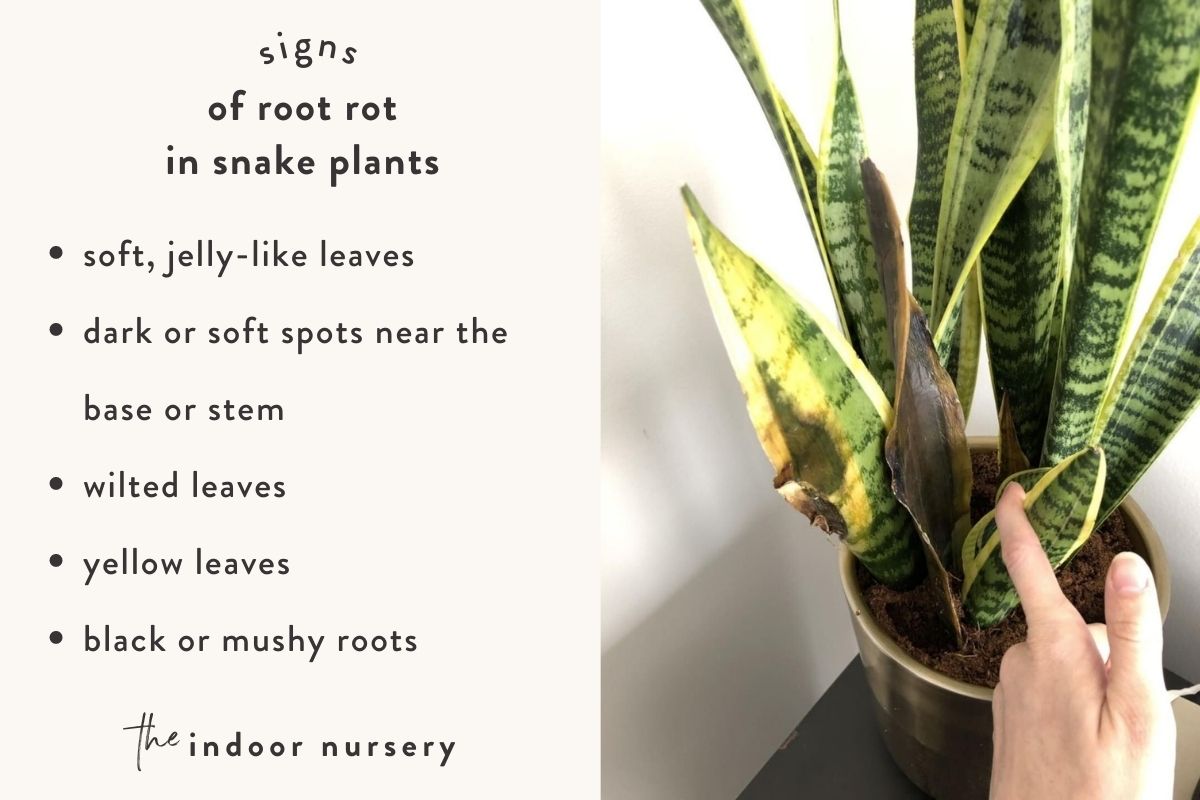
Ok, ok, we did name snake plants as one of the few plants that actually don’t need drainage to thrive. That’s true! *With the condition that you don’t overwater your snake plant.
When excess water stays in your potting soil or at the base of its pot for too long, the snake plant’s roots are unable to pull oxygen and nutrients from the soil.
Rot can quickly spread to other healthy roots, and the low oxygen levels in the wet soil can allow fungi such as pythium, Phytophthora, Rhizoctonia, Botrytis, Alternaria, and Fusarium to multiply. These colonies quickly move into the decaying root zone and get down to decomposition. Not good for your snake plant ❌
Early indicators of snake plant root rot
The reason root rot tends to strike fast and fatally is because most plant owners don’t regularly examine their plants’ roots for signs of distress.
This is exactly why I love using a moisture meter… even just to grow snake plants. A moisture meter lets you check on moisture levels at the very bottom of your snake plant’s pot, where wet soil tends to high from the usual finger-poke test.
However, if you don’t have a moisture meter, then your snake plant will give you warning signs up top that something’s off underground. Here’s what to look for in your snake plant’s appearance:
- Soft, jelly-like leaves. This is the first sign that your snake plant may be developing root rot. To look for this, lightly squeeze one of your plant’s long leaves between your fingers. The leaf should be plump and taut (plant nerds use the term turgid) from the tension of the water held inside. If the leaves are jelly-like or soft, this is a sign that something’s up in the root zone.
- Dark or soft spots near the base or stem. When you notice these dark or soft spots at leaf bases, remove the plant from the soil and look at the roots to confirm your suspicion.
- Wilted leaves. Wilted snake plant leaves can be caused by a number of factors, including underwatering and inadequate light exposure. If you have looked at potential other causes for wilted leaves and come up short, it is a good idea to check your plant for additional root rot symptoms. The difference here is that the wilted leaves will likely be mushy or at the very least squishy.
- Yellow leaves. Yellow leaves are generally a sign of poor drainage and overwatering. If your plant has yellow leaves, make sure to check that the water is able to drain properly and look for signs of root rot.
- Black or mushy roots. If this is the case, we have bad news—the root rot has progressed significantly. When a plant is experiencing root rot, the affected roots turn black and often become mushy. A root that is rotted will separate from the plant as soon as you touch it. However, in many cases, not all the plant roots will have rotted, and the rotted ones can be removed to help rehabilitate the snake plant.
What causes root rot in a snake plant?
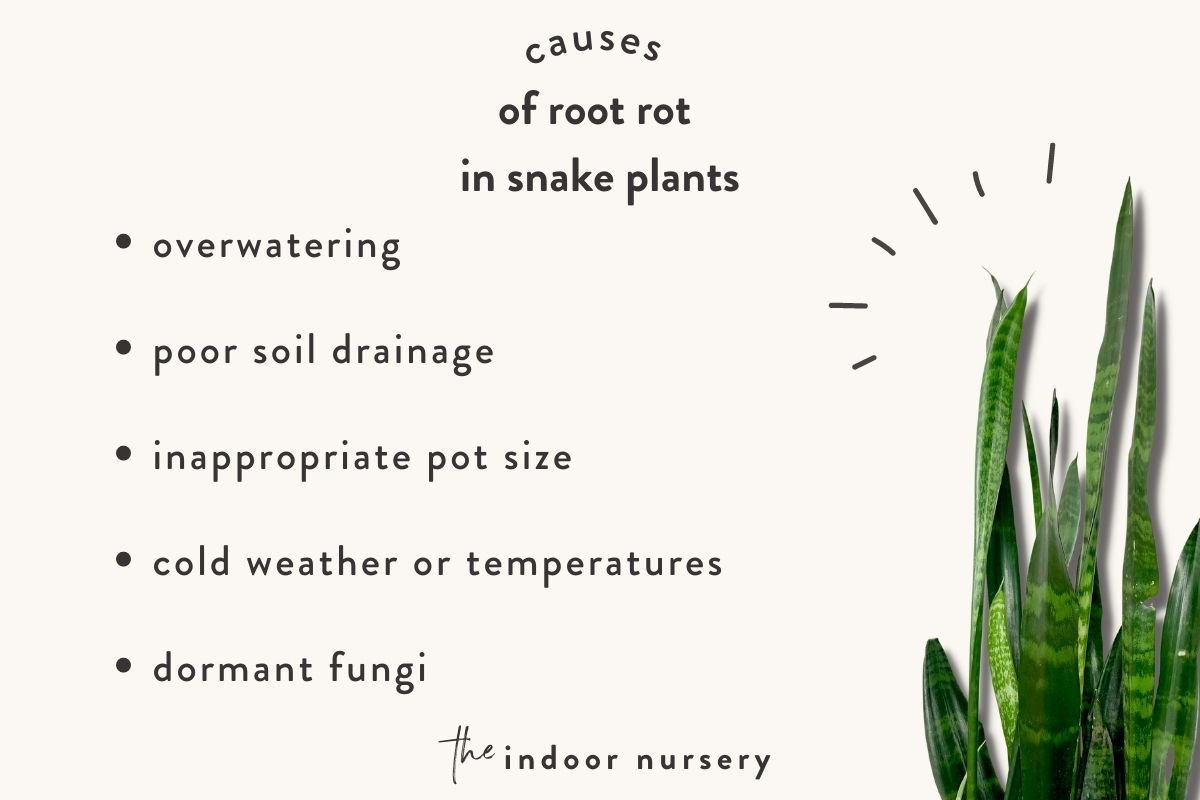
The base cause of root rot in snake plants is that their roots are oversaturated in water. While overwatering is one cause of this problem, water can also accumulate around a snake plant’s root zone for other reasons. Diagnosing the particular reason that your snake plant is waterlogged is the first step in rehabilitating it – and avoiding future root rot.
Common causes of snake plant root rot
- Overwatering. When you overwater your snake plant, the soil cannot properly dry out. This causes the roots to become waterlogged, and leads to rot.
- Poor soil drainage. Even if you are watering your snake plant appropriately, poor soil drainage can quickly lead to too much moisture in the soil and even prevent the roots from absorbing the moisture that is present. When the soil doesn’t drain well, water fills all of the pore space in the soil and leads to trouble. Make sure to use the best soil for snake plants the next time you repot your dracaena!
- Inappropriate pot size. When a pot is too big, it will tend to hold more water than your snake plant needs, leading to mold growth and soil saturation. The large pot size keeps the soil wet for too long and encourages bacterial and fungal growth.
- Cold weather or temperatures. When the air is cold around the snake plant, it can prevent the soil from drying properly. It takes an extended time for any excess moisture to evaporate, leaving the roots to sit for a prolonged time in a damp environment.
- Dormant fungi. Sometimes, fungi are present in the soil but dormant. When the soil becomes waterlogged, the fungal spores can quickly take action and attack the root of the plant.
How to save a plant after root rot
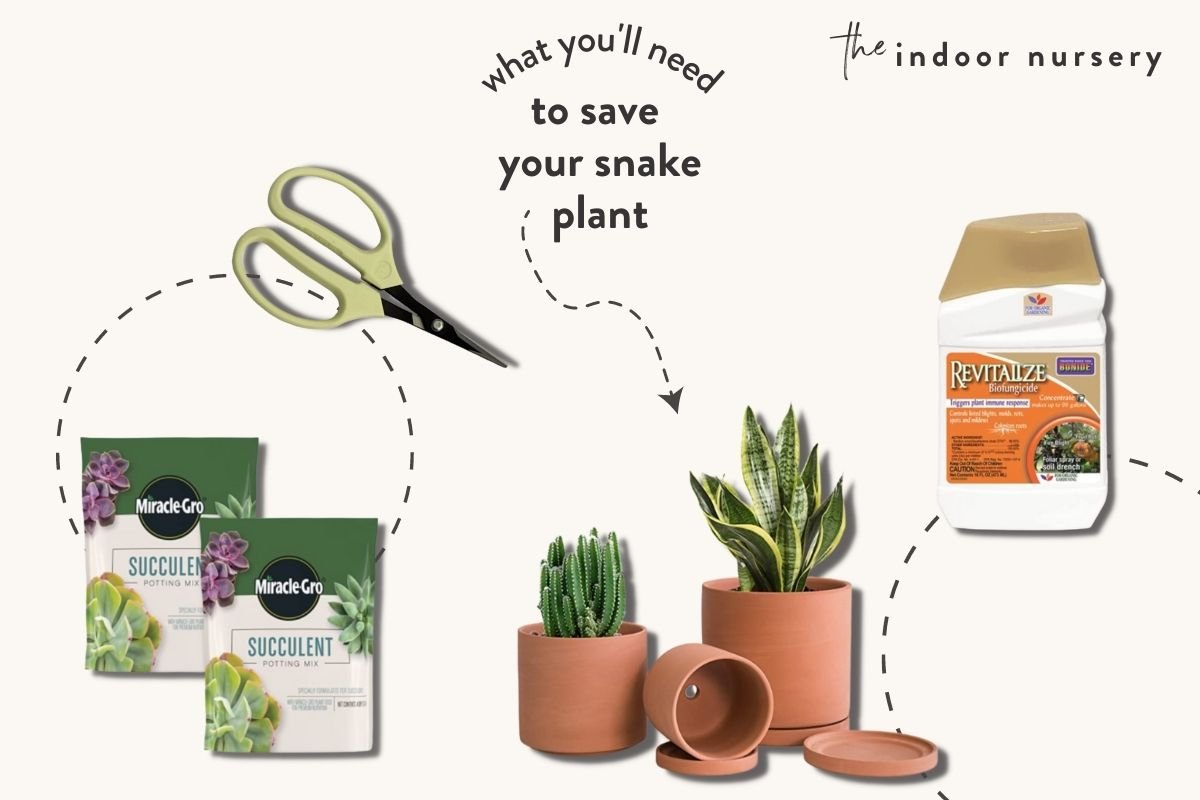
If you’ve noticed the signs of root rot in your beloved snake plant and want to save it, you have a few options.
With all the doom and gloom ⬆️ we’ve covered so far, you may be wondering: Can a snake plant recover from root rot?
If the root rot is in its early stages, yes! The key to treating root rot is to remove your plant and replace the affected soil immediately to stop the problem from spreading. After this, remove any rotted roots and repot the plant in fresh soil.
You can add mycorrhizae treatment, cinnamon, or sulfur powder to the roots to help prevent fungal growth.
Otherwise, follow these steps to fix root rot in your snake plant:
What you’ll need:
- Sanitized cultivation scissors
- Fungicide solution
- Pot with a drainage hole
- Succulent potting soil mix
How to save your snake plant from root rot
- Tip your snake plant on its side, if possible, and gently pry it loose from its pot.
- Shake the soil free from the root ball to examine the roots more closely.
- Examine your snake’s roots, gently untangling them to observe the affected area. Separate rotting roots (black and mushy) from healthy roots (white and firm). Use your sanitary scissors to snip the mushy roots away from the root ball.
- Mix your fungicidal solution as directed and treat the remaining roots. (Not all plants are healthy enough for fungicide, so you’ll need to make a judgement call on this step.)
- Prepare your new pot with fresh potting mix. If using the same pot, wash it thoroughly before filling with fresh succulent soil. (Fungus spores remain in the old pot, so this step is important.)
- Repot your snake plant and fill in with fresh potting soil. The root and shoot space should leave about 1-2 inches for root growth.
- Place the plant away from direct sunlight to recover.
- After 1-2 weeks, resume watering.
Natural ways to treating root rot
While fungicides and other commercial treatments can be effective for treating root rot, some people prefer to use household items to help combat the problem. Here are a few options:
- Cinnamon: Cinnamon is a natural antifungal agent and can be used to treat root rot in snake plants. Simply sprinkle cinnamon powder on the infected roots and soil’s surface, then let it sit for a few hours before watering your plant.
- Hydrogen peroxide: Hydrogen peroxide can help to oxygenate the soil and kill off harmful bacteria and fungi. Mix one part hydrogen peroxide with three parts water, then use this solution to water your plant.
- Vinegar solution: Vinegar is another natural antifungal agent that can be used to treat root rot. Mix one part vinegar with three parts water, then water your plant with this solution.
- Bleach solution: While bleach is a powerful disinfectant, it should be used with caution when treating root rot in snake plants. Mix one part bleach with nine parts water, then use this solution to soak the infected roots for about 20 minutes before rinsing them off with plain water.
It’s worth noting that household remedies may not be as effective as commercial treatments, and some may even harm your plant if used improperly. Always test a small area of your plant before treating the entire plant and be cautious when using any household item to treat root rot.
How to prevent root rot
As any of us who have dealt with a root rot fiasco have learned, prevention is much easier than trying to combat the problem. To prevent root rot, start with an appropriate watering schedule and good drainage to ensure that your snake plant is getting the oxygen and water it needs to thrive.
Top root rot prevention strategies
- Don’t overwater. Yep, you heard me. Just don’t do it!! During winter, snake plants only need watering once or twice a month. In the summer, once every two weeks is generally enough to keep this succulent happy.
- Use a new potting mix. Using old soil can increase the changes of root rot because of potential dormant fungal spores. Make sure you always start fresh with new soil.
- Disinfect pots before using. Similar to using fresh soil, it’s important to disinfect pots to ensure there are no dormant fungi waiting to attack.
- Use pots with drainage holes. Even if you are watering appropriately, inadequate water drainage can lead to waterlogged plant roots.
- Use the right soil mix. Using a soil mix specifically for succulents can help to give your snake plant the best environment to thrive.
- Don’t over compact the soil. This goes hand in hand with repotting (i.e. make sure you repot every year or two). Soil compacts naturally over time and needs to be changed to improve your plant’s drainage.
- Let the soil dry between watering. There is no one-size-fits-all when it comes to watering plants, and factors such as temperature, humidity, and sunlight can – and should – affect your watering schedule. To prevent overwatering, the best rule of thumb to follow is to wait for the soil to dry before watering the plant again.
How to water a snake plant
Even succulents, long hailed as the easiest plants to keep alive, can suddenly take a turn when the conditions aren’t right.
Snake plants are, in fact, a type of succulent known for their distinctive snake-like leaf patterns and zesty, striped green and yellow foliage. They are one of the most popular indoor plants for people who seem to kill everything else – and anyone who loved taking care of a Pet Rock as a kid 😂
Buuut, snake plants are animate, living organisms at the end of the day, not rocks 🪨 Occasionally your snake plant will show you signs that something is wrong. Because snake plants contain a high percentage of water in their leaves, a consistent watering schedule is actually quite important to this resilient plant’s overall health.
If you let your snake plant sit in water for a prolonged period of time or overwater your snake plant one too many times, you will likely observe a phenomenon called “root rot.”
Snake plants are pretty resilient, but it’s still important to water them properly to keep them healthy and happy. Here are some best watering practices to keep in mind:
- Water deeply, but infrequently. Instead of giving your snake plant a little bit of water every day, it’s better to water it deeply (until water runs out of the drainage holes) but less frequently (once every 1-2 weeks). This will allow the soil to dry out partially between waterings, which can help prevent overwatering and root rot.
- Check the soil moisture. Before watering your snake plant, check the soil moisture by sticking your finger about an inch into the soil. If the soil feels dry, it’s time to water. If it’s still moist, wait a few more days before checking again. A moisture meter is perfect for this because the probes allow you to see the soil moisture at the bottom of the pot.
- Use well-draining soil. Snake plants prefer well-draining soil that allows excess water to flow out of the pot. You can use a cactus soil or succulent mix… or make your own by mixing equal parts of potting soil, sand, and perlite.
- Avoid getting water on the leaves. Snake plant leaves are sensitive to water spots, so it’s best to water the soil directly instead of spraying the leaves with water.
When it comes to watering snake plants, less is often more. Overwatering is one of the most common causes of root rot in these plants, so be sure to give them a chance to dry out between waterings.
And if you’re ever unsure about whether your plant needs water, just stick your finger in the soil and give it a little poke. 👉
Common questions
How long does it take for a snake plant to recover from root rot?
Well, that depends on a few things. If you catch the root rot early and treat it promptly, your snake plant can recover in as little as a few weeks to a few months. However, if the root rot is severe and has caused significant damage to the roots, it may take several months for your plant to fully recover.
Now, I know waiting for your plant to recover can feel like watching paint dry, but don’t worry! With a little patience and some proper TLC, your snake plant can make a full recovery and continue to thrive. Just make sure to provide your plant with the right amount of light, water, and nutrients, and avoid overwatering to prevent the root rot from returning. Remember, slow and steady wins the race when it comes to plant care!
Can I use household items like cinnamon, vinegar, or rubbing alcohol to treat snake plant root rot?
Yes, household items like cinnamon, vinegar, and rubbing alcohol can be used to treat snake plant root rot. Cinnamon is a natural antifungal agent that can help to combat fungal infections in the soil, while vinegar is a natural antimicrobial agent that can help to kill harmful bacteria and fungi.
To use cinnamon to treat snake plant root rot, simply sprinkle cinnamon powder on the affected roots and soil, then let it sit for a few hours before watering your plant. To use vinegar, mix one part vinegar with three parts water, then water your plant with this solution.
Alcohol can help to kill off bacteria and fungi, which can be beneficial in treating root rot. However, it’s important to be cautious when using rubbing alcohol on your snake plant. Rubbing alcohol can be quite harsh on plants and can cause damage if not used properly.
To use rubbing alcohol to treat root rot in a snake plant, mix one part rubbing alcohol with three parts water, then use this solution to water your plant. Alternatively, you can apply the solution directly to the infected roots with a cotton swab or brush.
It’s important to make sure that your snake plant is not sensitive to these household items before using them as a treatment. Always test a small area of your plant before treating the entire plant, and consult with a plant expert if you have any concerns.
What is the ideal well draining potting mix for snake plants?
The ideal well-draining soil mix for snake plants is one that allows for good air circulation around the roots and doesn’t hold onto excess moisture. A good soil mix for snake plants should be well-aerated, allowing water to pass through easily, while also retaining enough moisture to keep the roots hydrated.
A popular soil mix for snake plants is a combination of potting soil, coarse sand or perlite, and peat moss or coconut coir. The ratio of these ingredients can vary depending on the specific needs of your plant, but a good starting point is one part potting soil, one part coarse sand or perlite, and one part peat moss or coconut coir.
It’s also important to choose a pot with good drainage holes to ensure that excess water can drain out of the soil quickly, preventing the roots from becoming waterlogged and susceptible to rot.
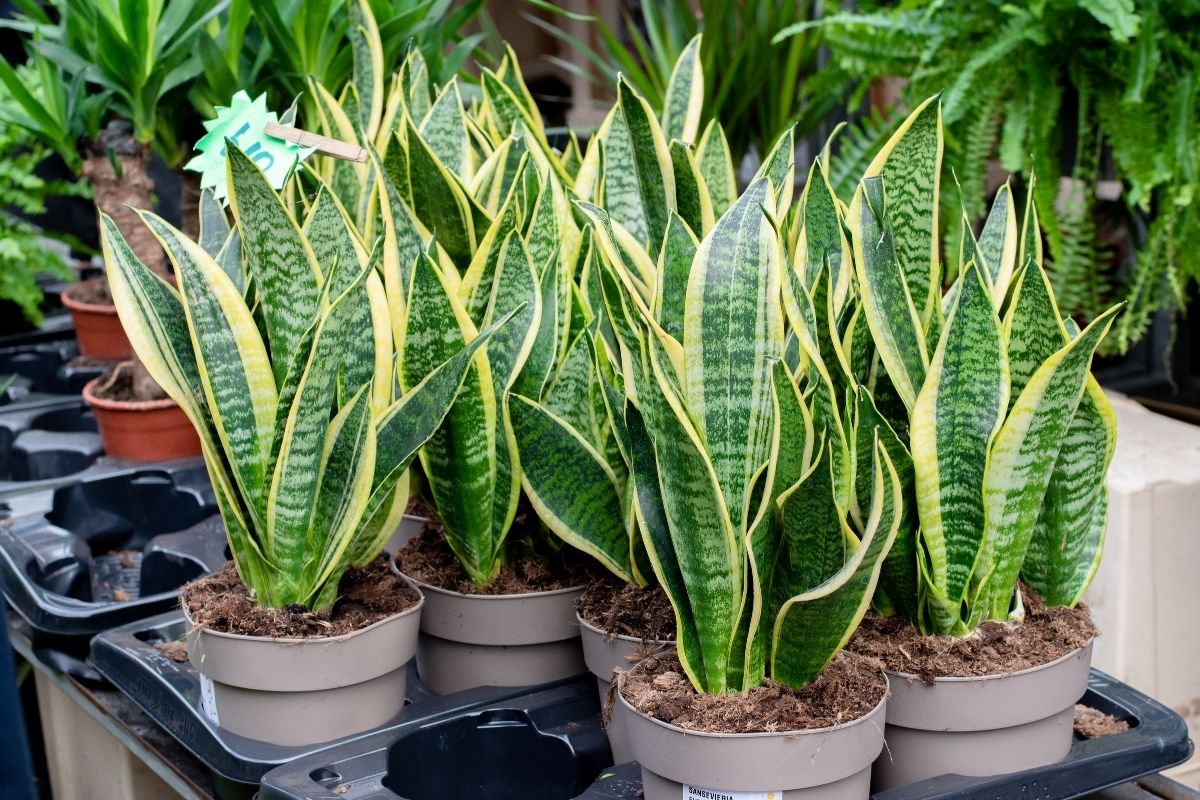
The bottom line
Plants are a great way to brighten your living space and have been shown to have beneficial effects on air quality, stress levels, and fatigue. However, pesky plant problems like root rot can definitely cause more stress when they get out of hand. Understanding the signs, treatments, and preventative measures for root rot in snake plants will help you care for this resilient plant like a pro. Happy gardening!
Read more about snake plants
- How Often To Water Dracaena (Including Snake Plants)
- How To Save An Overwatered Snake Plant
- Growing Dracaena Marginata: Care Tips
- Best Soil For Snake Plants That Will Keep Them Happy
- Snake Plant Care: how to keep them happy
- How To Choose The Best Snake Plant Fertilizer
- Snake plant root rot (and how to save it)

